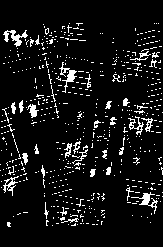
Home
Articles
Reviews
Hot Links
About Us
|
Bill Dixon Vade Mecum
Bill Dixon - trumpet, flugelhorn Barry Guy - doublebassWilliam Parker - doublebass Tony Oxley - percussion
|
|
|
1. Moment - (4'24") “ How motion hereby is sensed in the minutae of tones” “implication dominates how rhythms and pulse function more for their coloristic value than as velocities in a metric framework. Sounds are juxtaposed to intervallic sense, one to another so that the focal point of any passage is its direction rather than a tonal center” -Ben Young-
“A musicians is more than a person who plays an instrument. The musician is an engineer of sound and should utilize any and every aspect of sound in the production of music" -Musician/Composer Jimmy Stewart-
“every instrument encompasses an orchestra”
All these comments summarize concepts that some musicians have been developing since the 60’s. Unlike many of the revivalist tendencies of today, the “jazz musician” (to use a common reference term which still has pejorative implications today) was formerly defined as someone who played the instrument like no one else. Bill Dixon’s personal approach and mastery of the trumpet is rarely discussed in the United States. His brilliance and purity of sound is compelling. The sudden tutti entrance is a fitting first take. Here are beautiful phrases constructed of fourths and fifths embellished by warm scalar colorings, poignant changes in register, and a modality not unlike the work of Miles Davis and John Coltrane particularly in the way Mr. Dixon can reduce a musical event to one sound or a few slow notes contrasted with evocative silences and compressed phrases. I remember Bill Dixon saying that any sound can be used. “Noise” is equally expressive as a pristine tone. The listener might occasionally confuse a bowed bass note with a trumpet tone or the reverse. Beginning Anamorphosis ,(in contrast to Moment) Mr. Dixon plays speech like noises in the extreme registers of the trumpet. Witness also the sense of motion generated by two sudden airy bursts at the beginning of Viale Nino Bixio 29 which is immediately picked up by the basses and gradually builds to a soft but fast pulse and then a quick dissolution tapering to two long tones. Beginnings and endings are arresting and clearly defined. Much of the intensity and momentum is accomplished without the density and volume associated with other artists in this music. Cecil Taylor remarked that he learned from Ellington how instruments can sing together, if you choose the right timbre. Bill Dixon’s ensemble demonstrates an affinity for reflective timbre in the way instruments cross registers and imitate each other’s nuances. Notice this 6:30 into Pellucity where for about thirty seconds all the instruments alternate between blending and leaping out of the texture nearly indistinguishable from one another. Bill Dixon may at times encompass several registers in one phrase. He has thought to use every possible register to create a musical orchestral spread. In this sense and because of the orchestration and rhythmic activity, four instruments can at times seem like many more. The basses respond equally to the challenge. On Twice Upon a Time, Barry Guy’s arco seems to follow every timbre, gesture, and register presented by the trumpet while William Parker plays slow intermittent pizzicato at points building to a quick pace after which a section is developed as the drums stop playing. Listen to the last three minutes. Amidst shrieks and flutters from the trumpet, one bass responds with short quick phrases while the other bows low and softly, so softly that at first the listener senses its presence but not its individual sound (as if the attack is hidden). Barry Guy voices over the trumpet. A quick cadence is made as the trumpet returns with the basses playing in the trombone register. The abrupt changes in register impart a form eventful and captivating. The immediacy and sensitivity by which each musician can begin, accompany, and end or continue each others musical statements, the sense of impact, the subtle reactions of human timing all indicate a high level of attunement and acuity. For those who are musicians or for anyone who views music as a form of knowledge like other arts and sciences in these times where music is increasingly a commodity that provides comfort and reassurance, this recording is a testament to the sound potential and subtleties of instruments in the twentieth century. We praise synthesis for its own sake. We praise whimsical gimmicks for their sense of the unusual. We praise reproductions and dedications to the past like offerings upon an alter. Rather than curious or mystified, we are uncomfortable with the unfamiliar, and so we claim that the artist is impoverished by his or her limitations, but I believe it is the way an individual adheres to a particular limitation that separates that person from the interpreter and makes that person an artist. "Limitation of means determines style, engenders new form, and gives impulse to creation." -George Braque "Thoughts and reflections on Art 1917"
-Eric Zinman =
|